|
JANUARY 2007
WHERE HAS WINTER GONE?
By Sandy Leven
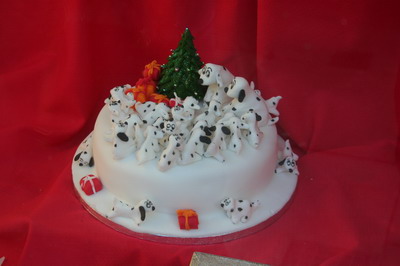
A wonderful festive cake which I spied in Broughty Ferry
Happy New Year!
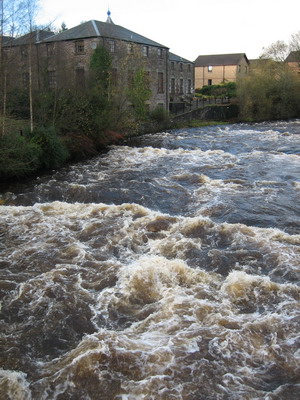
The Allan Water in spate at Dunblane at New Year
New Year's Day 2007 got off to a wild and stormy start and half way through the month it is still wild and stormy. Although I did not plan to attend any, I noted that the official New Year celebrations were cancelled in Glasgow, Edinburgh, Stirling and Newcastle but Inverness celebrated with a great fireworks display. Londoners also could gather opposite the London Eye to enjoy their fireworks. I think I would much prefer the fireworks to jumping into a fountain in Trafalgar Square!
All the rain caused the river Forth to burst its banks and flood a wide area of the Carse of Stirling. High tides frequently cause some flooding but this year's was exceptional.
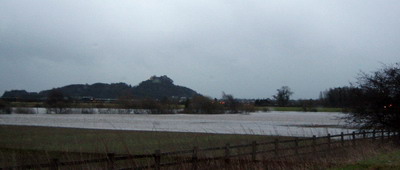
Stirling castle above the flooded Carse land
New Year's Day in the garden showed that some plants were flowering well ahead of their usual time while others were still in flower when they should have been past. Whin [gorse] bushes near Dunblane are in flower in mid January and the yellow is most welcome on a dreich winter's afternoon.
Cyclamen hederifolium is an autumn flowerer but this plant in the alpine house has kept its flowers for months. All the others are well past flowering. I wondered if it might be a plant with sterile flowers but when I moved the leaves aside to prove my theory I found some coiled up stems setting seed. The only other explanation I can think of is that the plant started into flower much later than all the other hederifoliums by which time all the wee pollinating hover flies and their like had passed away. On warm autumn days the hover flies pollinate Cyclamen flowers almost as soon as they open, especially under glass, with the result that the flowers drop off within days of opening [and fertilisation].
WONDERFUL WINTER IN SCOTLAND

Ben Lawers touched with snow
Mid month, on a wonderfully bright Wednesday, we drove up Glen Ogle, past Ben Lawers to Rannoch Moor and the Top of Glen Coe to see the mountains in the snow.
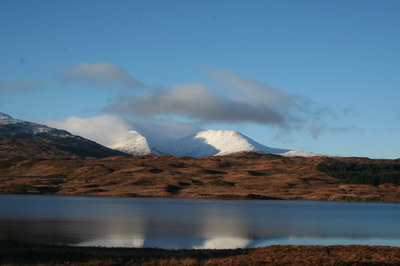
Rannoch Moor
Just to see the hills raises the spirits. To see white snow covered mountains under blues skies is exhilarating.
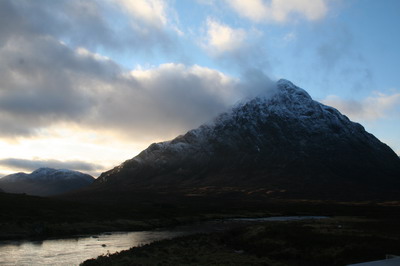
Buchaille Etive Mor
The red deer decided to do their bit for tourism. Most drivers sped on their way oblivious to the deer. No wonder they did not se them. They are perfectly camouflaged.
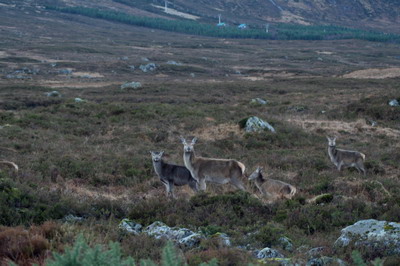
The winter moorland was brown but there were reminders of summer glories. Dried stems of bog asphodels stood like sentries amongst bog myrtle

We had a good meal at the Kingshouse Hotel at the top of Glen Coe. It gets a hungry 3 stars from my family. The hotel must be the best base from which to visit the Glen and Moor.

Red Deer at the Kingshouse Hotel, with Buchaille Etive Mor
[the blue sky had disappeared by this time]
FLOWERS
In September I planted some 'Mini Cyclamen' plants from B&Q in a planter for my daughter's flat in Dundee. In January 4 or 5 months later they are still in flower and in pretty good condition. [considering that students do not dead head plants]
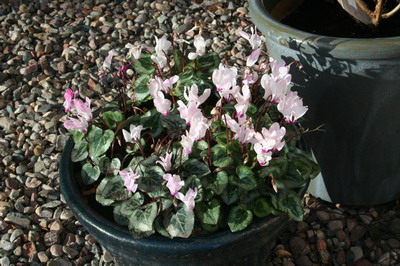
'Mini Cyclamen' still in flower after 4 months

Ipheon uniflorum
This is first time I have flowered an Ipheion uniflorum. I was amazed to see the flower stems appear in November and then delighted at the white wheel shaped blooms. They last for ages. This is their 10th week in flower. A few very cold nights have caused the flowers stems to bend a bit, so that the pan looked a bit sad but a few warmer sunny days perked them up. Out in the frame a pan of Ipheion 'Rolf Fiedler' is sending up lowering stems. I am looking forward to its pale blue flowers and I hope they will be in good condition for the Early Bulb Show in Dunblane. Ipheons are in the Alliaceae family and come mostly from Uruguay and Argentina.
[ I must find out who is Rolf Fiedler. On the internet I have found a Rolf Fiedler who is an electronic design engineer with a firm called Ferrari electronics in Germany.]
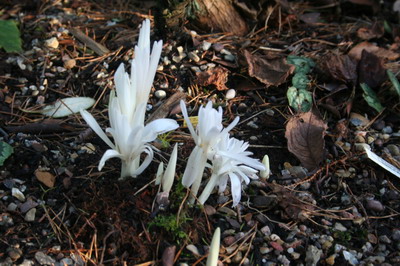
Colchicum autumnale flore plena album flowering in January
The mild weather did not last! mid month brought lots of snow which covered up everything in the garden, even the flowers of Colchicum autumnale flore plena album which appeared on the 14th of January. I did not notice these flowering in October when they should have and perhaps the mild autumn and winter lulled them into thinking that autumn had not arrived. I am tempted to claim that global warming has caused them to flower 9 months early rather than 3 months late.
AMARYLLIDACEAE
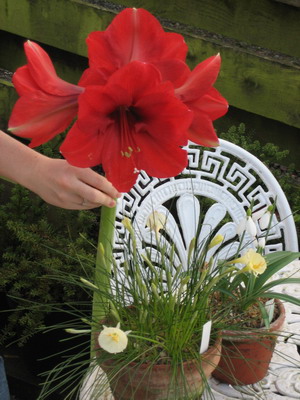 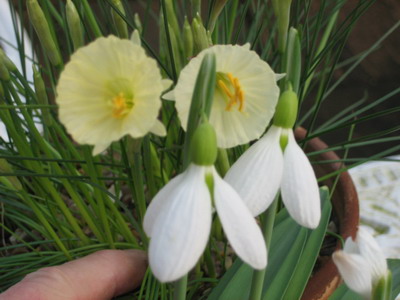
Amaryllis, Narcissus and Galanthus
3 members of the Amaryllidaceae are Amaryllis, Narcissus and Galanthus. While the first comes from South America and is tender the Galanthus is very hardy. Some Narcissus are hardy and some are not. It is wonderful that they all can perform well in mid winter, but look at the difference in flower sizes! Who would think these were all cousins? Each is valuable in its own way. I love the big Amaryllis flowers in the conservatory at Christmas time.
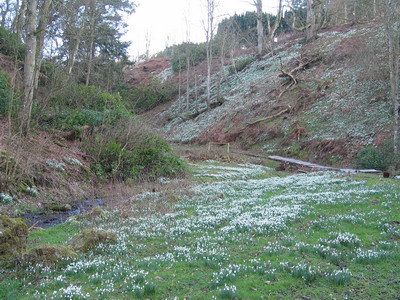
'Wild snowdrops in Scotland.
These must have been planted in Victorian times and have multiplied and seeded right down the glen.
Snowdrops are erupting through the gravel in their pots. I had begun to think that there was a natural order in which Snowdrops appeared and that they would come up in the same order each season but apparently not. I always expect to see flowers on Galanthus 'Augustus' before my other snowdrops, closely followed by G. Allenii. Perhaps the same conditions in the same year suit the same bulb. Two pans of Galanthus 'Hayden' are at the same stage of emergence tho' they are in different frames.
This year, the furthest advanced is a superb hybrid which I got from a good friend. It is a Galanthus nivalis x plicatus hybrid with wonderful leaves; in fact I have labelled it 'Look at these leaves' and that is what I call it. This plant is probably still settling into my collection so it may in future be first to flower each year.
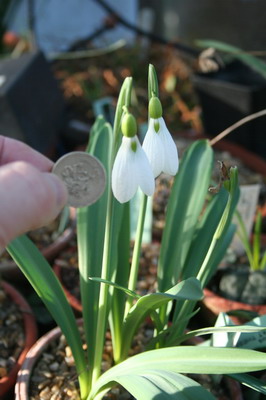
Galanthus nivalis x plicatus
I am pleased to see seed capsules forming on 2 pans of G. reginae-olgae. So far I have not had seed on my plants of Queen Olga's snowdrop and I presume that they have set seed this season because I now have two different clones.

Galanthus reginae-olgae 'Hyde Lodge'
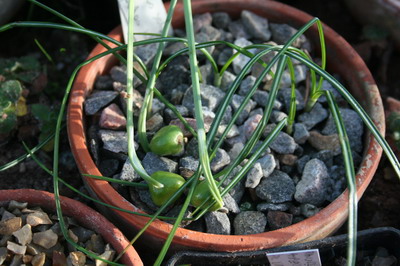
seed pods
I am looking forward to February when we can again see acres of 'wild snowdrops'.
Ian Y says, 'There is only one snowdrop!' How can he sleep at night?
There seems to me be a huge amount of variation in what is always a wee white drop shaped flower. Every snowdrop looks like a snowdrop. I am amazed to see in areas where they grow in masses that there can be virtually no variation in the flowers but when you visit a collection of named forms and hybrids there are differences which are readily discerned even by an novice. I can appreciate the differences between clones but would be hopeless at naming an individual selected form. I delighted when I spotted a different flower like one with 4 outer and inner petals instead of 3.
I did once find one which was almost poculiform [i.e. the inner and outer petals are the same length]. It is not quite perfect but it seems to grow well. For my own sake I labelled it 'Wedding Dress'

SRGC president Ian Christie
Ian Christie grows some as edging to a path in the garden in his nursery. They look great. When they start to go over the leaves will be no nuisance here between path and rocks.
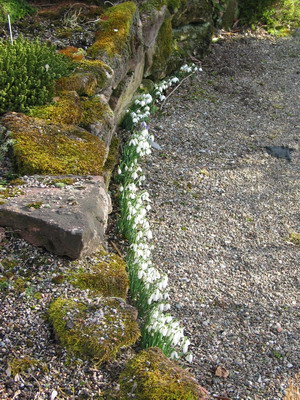 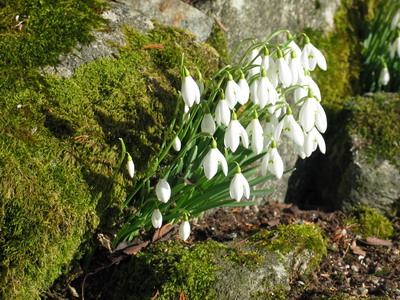
Snowdrops beside a path in President Ian's garden
In the open garden there is a danger of planting something on top of the dormant snowdrop bulbs.
NAMING SNOWDROPS
We are exhorted by 'the experts' not to give names to our own clones in case they have already been named by some one else. [ This does not stop 'the experts' from naming new selections quite regularly.]
When it comes to seedlings and 'wild' plants, however, these may be similar to forms already named but are very unlikely to be the same clone. It is important for gardeners to have plants which grow well for them in their own garden. Some named clones of Snowdrops are expensive and do not always multiply as well as might be hoped for everyone. Therefore if a plant turns up in your garden or you are given an un-named form by a friend, then I think you are entitled to label it. You could give it a number [like the accession numbers botanic gardens use] or just call it 'Wullie's form' or 'Mary Doll's Snowdrop'. The only problem comes if somebody wants to commercialise it and make money. Then it would be necessary to make certain it was not an already known form. With the help of its current 'Mary Doll' label at least part of its recent history is recorded. All plants given away by the namer of 'Mary Doll' will at least have the same name and can be corrected together if necessary. New selections from one's own
seedlings and selected plants from wild populations will most certainly be new clones. We must remember tho' that it is illegal to dig up plants from someone-else's property and I suspect in most places overseas where they grow wild. I think all Galanthus are on the Cites list of endangered plants.
A couple of years ago B&Q sold pots of Galanthus elwesii and G.woronowii. In each pot there were plants with different flowers. I tried to select out some but they did not prosper. Part of the reason was that I kept them in their plastic pots and in their peat compost and we had a wet summer, causing rot in the basal plates. Still it was a nice way to pass the early spring.
SNOWDROP FESTIVAL
Soon It will be opening time at the 60 Snowdrop venues taking part in Scotland's Snowdrop Festival. I plan to visit as many places as I can but as I will be working during the period my visits will be limited.
Check out the gardens on www.visitscotland.com/snowdrops
Just when we got used to the mild wet weather, snow arrived in abundance. I hoped for more than we got but unfortunately was able to get to work. Still many other folk were snowed in and I did manage to get a half day. We live up a steep hill and he road proved very difficult to drive up. Our neighbour's Eucalyptus gunnii was heavily laden with snow and was very bent over for a while. It has been cut back several times over the last 25 years as it always eventually fall s over our driveway and prevents the cars getting in.
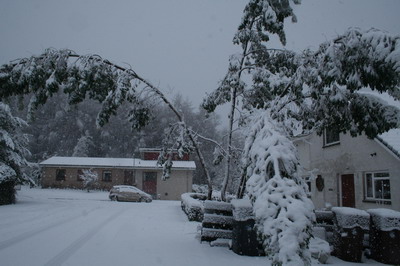 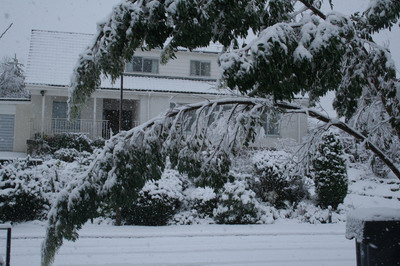
Eucalyptus gunnii in the snow
^ back to the top ^
|

